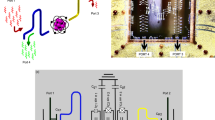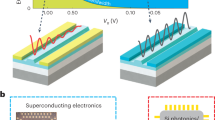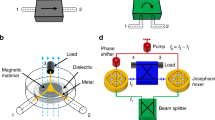Abstract
The readout of microwave quantum systems, such as spin or superconducting qubits, requires low-noise amplifiers with added noise as close as possible to the quantum limit. This limit has so far been approached only by parametric amplifiers that exploit nonlinearities in superconducting circuits and are driven by a strong microwave pump tone. However, this microwave drive makes the amplifiers much more difficult to implement and operate than conventional d.c.-powered amplifiers, which currently suffer from much higher noise. Here, we show that a simple d.c.-powered set-up can provide amplification close to the quantum limit. Our amplification scheme is based on the stimulated microwave photon emission accompanying inelastic Cooper-pair tunnelling through a d.c.-biased Josephson junction. The key to the low noise of this approach is a well-defined auxiliary idler mode, which allows for operation analogous to parametric amplifiers.
This is a preview of subscription content, access via your institution
Access options
Access Nature and 54 other Nature Portfolio journals
Get Nature+, our best-value online-access subscription
$29.99 / 30 days
cancel any time
Subscribe to this journal
Receive 12 digital issues and online access to articles
$119.00 per year
only $9.92 per issue
Buy this article
- Purchase on Springer Link
- Instant access to full article PDF
Prices may be subject to local taxes which are calculated during checkout




Similar content being viewed by others
References
Caves, C. M. Quantum limits on noise in linear amplifiers. Phys. Rev. D 26, 1817–1839 (1982).
Yurke, B. et al. Observation of 4.2-K equilibrium-noise squeezing via a Josephson-parametric amplifier. Phys. Rev. Lett. 60, 764–767 (1988).
Castellanos-Beltran, M. A. & Lehnert, K. W. Widely tunable parametric amplifier based on a superconducting quantum interference device array resonator. Appl. Phys. Lett. 91, 083509 (2007).
Bergeal, N. et al. Phase-preserving amplification near the quantum limit with a Josephson ring modulator. Nature 465, 64–68 (2010).
Roch, N. et al. Widely tunable, nondegenerate three-wave mixing microwave device operating near the quantum limit. Phys. Rev. Lett. 108, 147701 (2012).
Mutus, J. Y. et al. Strong environmental coupling in a Josephson parametric amplifier. Appl. Phys. Lett. 104, 263513 (2014).
Roy, T. et al. Broadband parametric amplification with impedance engineering: beyond the gain–bandwidth product. Appl. Phys. Lett. 107, 262601 (2015).
Simoen, M. et al. Characterization of a multimode coplanar waveguide parametric amplifier. J. Appl. Phys. 118, 154501 (2015).
Macklin, C. et al. A near-quantum-limited Josephson traveling-wave parametric amplifier. Science 350, 307–310 (2015).
Hover, D. et al. Superconducting low-inductance undulatory galvanometer microwave amplifier. Appl. Phys. Lett. 100, 063503 (2012).
Lähteenmäki, P., Vesterinen, V., Hassel, J., Seppä, H. & Hakonen, P. Josephson junction microwave amplifier in self-organized noise compression mode. Sci. Rep. 2, 276 (2012).
Lähteenmäki, P. et al. Advanced concepts in Josephson junction reflection amplifiers. J. Low Temp. Phys. 175, 868–876 (2014).
Holst, T., Esteve, D., Urbina, C. & Devoret, M. H. Effect of a transmission line resonator on a small capacitance tunnel junction. Phys. Rev. Lett. 73, 3455–3458 (1994).
Hofheinz, M. et al. Bright side of the Coulomb blockade. Phys. Rev. Lett. 106, 217005 (2011).
Leppäkangas, J., Johansson, G., Marthaler, M. & Fogelström, M. Nonclassical photon pair production in a voltage-biased Josephson junction. Phys. Rev. Lett. 110, 267004 (2013).
Westig, M. et al. Emission of nonclassical radiation by inelastic Cooper pair tunneling. Phys. Rev. Lett. 119, 137001 (2017).
Russer, P. Parametric amplification with Josephson junctions. Archiv für Elektronik und Übertragungstechnik 23, 417–420 (1969).
Russer, P. & Russer, J. A. Nanoelectronic RF Josephson devices. IEEE Trans. Microw. Theory Techn. 59, 2685–2701 (2011).
Jebari, S. The Inelastic Cooper Pair Tunneling Amplifier (ICTA). PhD thesis, Université Grenoble Alpes (2017).
Ingold, G.-L. & Nazarov, Y. V. in Single Charge Tunneling: Coulomb Blockade Phenomena in Nanostructures (eds Grabert, H. & Devoret, M. H.) 21–107 (Plenum, New York, 1992).
Basset, J., Bouchiat, H. & Deblock, R. Emission and absorption quantum noise measurement with an on-chip resonant circuit. Phys. Rev. Lett. 105, 166801 (2010).
Safi, I. & Joyez, P. Time-dependent theory of nonlinear response and current fluctuations. Phys. Rev. B 84, 205129 (2011).
Roussel, B., Degiovanni, P. & Safi, I. Perturbative fluctuation dissipation relation for nonequilibrium finite-frequency noise in quantum circuits. Phys. Rev. B 93, 045102 (2016).
Chen, F. et al. Realization of a single-Cooper-pair Josephson laser. Phys. Rev. B 90, 020506 (2014).
Cassidy, M. C. et al. Demonstration of an AC Josephson junction laser. Science 355, 939–942 (2017).
Tien, P. K. & Gordon, J. P. Multiphoton process observed in the interaction of microwave fields with the tunneling between superconductor films. Phys. Rev. 129, 647–651 (1963).
Safi, I. & Sukhorukov, E. V. Determination of tunneling charge via current measurements. Eur. Phys. Lett. 91, 67008 (2010).
Parlavecchio, O. et al. Fluctuation–dissipation relations of a tunnel junction driven by a quantum circuit. Phys. Rev. Lett. 114, 126801 (2015).
Acknowledgements
The authors acknowledge discussions with J. Leppäkangas, C. Altimiras, M. Devoret, B. Kubala and J. Ankerhold, as well as financial support from the Grenoble Nanosciences Foundation (grant WiQOJo), the European Union (ERC starting grant 278203 WiQOJo and ICT grant 218783 SCoPE) and the ANR (grants Masquelspec, AnPhoTEQ, JosePhSCharLi).
Author information
Authors and Affiliations
Contributions
S.J., F.B. and A.G. performed the measurements and analysed the data. M.H., F.P. and D.V. designed and fabricated the sample. A.G., M.H., F.B., R.A., S.J. and D.H. built the set-up and wrote software. M.H. and S.J. wrote the manuscript with input from all authors.
Corresponding author
Ethics declarations
Competing interests
The authors declare no competing interests.
Additional information
Publisher’s note: Springer Nature remains neutral with regard to jurisdictional claims in published maps and institutional affiliations.
Supplementary information
Supplementary Information
Supplementary Note 1, Supplementary Figures 1–2
Rights and permissions
About this article
Cite this article
Jebari, S., Blanchet, F., Grimm, A. et al. Near-quantum-limited amplification from inelastic Cooper-pair tunnelling. Nat Electron 1, 223–227 (2018). https://doi.org/10.1038/s41928-018-0055-7
Received:
Accepted:
Published:
Issue Date:
DOI: https://doi.org/10.1038/s41928-018-0055-7
This article is cited by
-
Charge-4e supercurrent in a two-dimensional InAs-Al superconductor-semiconductor heterostructure
Communications Physics (2024)
-
High-fidelity quantum information transmission using a room-temperature nonrefrigerated lossy microwave waveguide
Scientific Reports (2022)
-
Cooper-Pair Tunneling in Small Josephson Junction Arrays Under Radio-Frequency Irradiation
Journal of Low Temperature Physics (2020)
-
Microwave amplifiers keep the noise down
Nature Electronics (2018)



